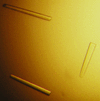issue contents
February 2018 issue

Cover illustration: Structural characterization of enoyl-ACP reductase II (FabK) from Porphyromonas gingivalis, a `keystone' species in periodontal disease (Hevener et al., p. 105).
research communications
The biophysical characterization and crystallization of the Pex4–Pex22 complex from H. polymorpha are reported.
In order to study the oligomeric structure of human CCL5, a new strategy to prepare the CCL5 trimer was developed and a crystal was obtained that diffracted to a satisfactory resolution of 1.87 Å.
Open  access
access
 access
accessThe oligomeric state of the 2-Cys peroxiredoxin from the green alga Chlamydomonas reinhardtii was determined by an X-ray crystallographic study and high-speed AFM image analysis.
Open  access
access
 access
accessAlthough the enzymatic activity of cytochrome c oxidase (CcO) depends sensitively on pH over a wide range, X-ray structural analyses of bovine CcO have been conducted using crystals prepared at pH 5.7 owing to the difficulty in crystallizing this protein. Here, the structure of ligand-free reduced CcO was successfully determined at 1.99 Å resolution.
Ribokinase from L. donovani was cloned, purified, characterized and crystallized, and data were collected to a resolution of 1.95 Å. X-ray crystallographic analysis showed the presence of two molecules in the asymmetric unit, and human ribokinase could be used as a template to determine the three-dimensional structure.
The structure of Porphyromonas gingivalis enoyl-ACP reductase II (FabK) was determined via X-ray crystallography to 1.9 Å resolution with all flexible loops visible, FMN fully resolved and the NADPH cofactor partially resolved. Characterization includes the structural basis of NADPH dependence and the role of a required monovalent cation.
Cellulosomes are capable of efficiently degrading cellulosic biomass. Crystallization and diffraction analysis of xylanase, which is part of the multi-enzyme cellulosome of Clostridium cellulovorans 743B, are reported.
Open  access
access
 access
accessPurification, crystallization and X-ray crystallographic analysis were employed to determine the catalytic mechanism of Est8, a GDSL-motif esterase from Bacillus sp. K91.


 journal menu
journal menu



















![[publBio]](/logos/publbio.gif)





